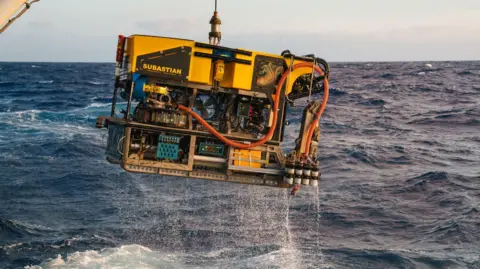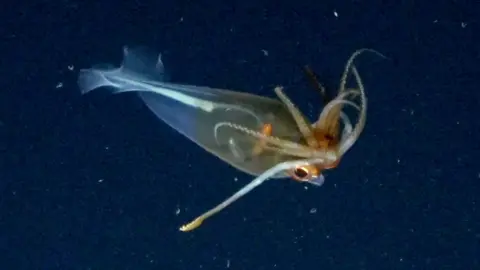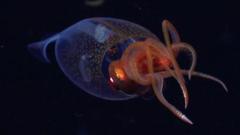Lewis Adams
BBC News, Essex
A colossal squid has been filmed in its natural environment for the first time since the species was discovered 100 years ago.
The 30cm-long (11.8in) juvenile was caught on camera at a depth of 600m (1,968ft), near the South Sandwich Islands in the south Atlantic Ocean.
A team of scientists, led by a University of Essex academic, recorded the footage in March during a 35-day quest to find new marine life.
Experts believe colossal squid can grow up to 7m (23ft) in length and weigh up to 500kg (1,100lb) – making them the heaviest invertebrate on the planet.
The mollusc was discovered on the 100-year anniversary of it first being identified and named.
Crew onboard the Schmidt Ocean Institute’s Falkor (too) vessel used a remote-controlled vehicle to spot it.

 Schmidt Ocean Institute
Schmidt Ocean Institute
Chief scientist Dr Michelle Taylor, from the university, said the team was initially unsure what the squid was but filmed it because it was “beautiful and unusual”.
The footage was then verified by Dr Kat Bolstad, who said previous squid encounters had mostly been as remains in whale and seabird stomachs.
“It’s exciting to see the first in situ footage of a juvenile colossal and humbling to think that they have no idea that humans exist,” she said.
Little is known about the colossal squid’s life cycle, but they eventually lose the transparent appearance of juveniles.
Another distinguishing feature of the species is the presence of hooks on the middle of their eight arms.
Dying adults have previously been filmed by people fishing, but have never been seen alive at depth.
The Natural History Museum has suggested it is hard to estimate the global population of colossal squids.
In 2022, the institution said the lack of observations meant that “even to this day, the enormous invertebrates still straddle the line between legend and reality”.

 Schmidt Ocean Institute
Schmidt Ocean Institute
Scientists also revealed that, in January, they captured footage of a glacial glass squid for the first time ever.
“The first sighting of two different squids on back-to-back expeditions is remarkable and shows how little we have seen of the magnificent inhabitants of the southern ocean,” added Dr Jyotika Virmani, Schmidt Ocean Institute’s executive director.
“These unforgettable moments continue to remind us that the ocean is brimming with mysteries yet to be solved.”







